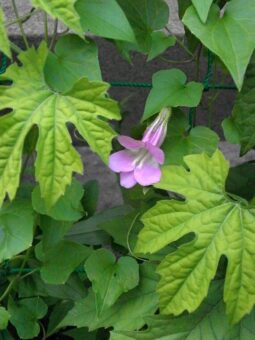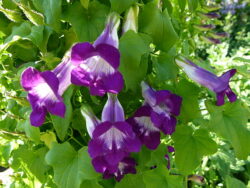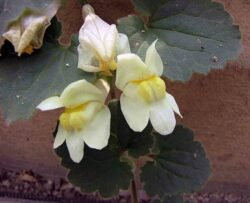In this article, we will discuss how to grow the climbing Asarinas in containers. Although it is a perennial and a climber, it is often treated as a half-hardy annual.

It has become increasingly popular in trailing hanging basket displays. It has the common name of Twining Snapdragons and this is adept for this climber. You will not find the plants often on sale because they do have a tendency to get entangled with each other. This will often lead to a mess and make the plants difficult to separate. This means you will need to start these beauties from seed if you want to succeed.
Asarina is a confusing genus as a lot of them have been reclassified to Maurandya, so Asarina scandens is now known as Maurandya scandens. You may still find it sold as Asarina.
This delightful plant produces trumpet-like tubular flowers of vivid colours of white, pink, lavender and blue that you wish to have in your garden. The flowers complement the arrow-shaped green leaves, where the beauty can be adored growing from a hanging basket.
It is a slow starter and you will need to plant them 12 weeks before the last frost date, so start in February.
GROWING ASARINAS FROM SEED
As you probably will not find plants sold in garden centres, it is better to buy and start from seed. The good news is that it is easy to start from seed, as you have the advantage of choosing what colour flowers that you prefer.
In February, you can start to plant your seeds indoors. Asarinas do not like the roots to be disturbed, so it is best to grow them individually in fibre pots. Plant 3 seeds in a pot and if 3 plants emerge then these should be thinned to one plant per pot. Keep the pots separate so that they do not entangle with each other as it climbs.

The process is simple, fill a 7cm pot with seed compost then water it until the compost is moist. Place the seeds on top and then just barely cover with more, sieved seed compost. Firm the top layer so it is in contact with the compost.
Place it in heat, an electric propagator is ideal and after 2 to 3 weeks the seeds should have germinated. Once it starts to twine, you may need to offer some support sticks to keep it growing upright and not sprawling all over the place. Keep it indoors until frost has passed and you are ready to plant it outside. Do not forget to harden off before filling your outdoor containers.
WHEN THE TIME COMES YOU CAN PLANT IT OUTSIDE
You can place the plant in a large container with a support frame to which the vine can grow up or you can let it dangle down from a hanging basket. Plant in a container full of multipurpose compost at the same level it comes in the fibre pots.
Firm the plant in and water well until it emerges from the container. Make sure that any container you use has drainage holes in them to allow excess water to drain away. My recommendation is to grow it in a hanging basket where a shower of colourful flowers can be admired.
The good news is that the plant is virtually pest-free and suffer from no diseases.
CARE OF ASARINAS
Grow your Asarina in full sun to light shade. In cool climates grow them in full sun, whilst in hot climates grow in light shade.
You will need to feed the plant monthly with a balanced liquid fertilizer that is high in potash to keep the plant in bloom.
Once blooms are spent it is better to deadhead regularly.
You will need to also remove untidy stems to keep the vine compact and tidy.
Water when 2.5cm below the surface of the compost feels dry to the touch when you stick your finger in. This could be frequent in hot weather.
It should be in flower from summer all the way to early autumn. Looks great if it is planted with garden verbenas.
VARIETIES TO GROW
Asarina antirrhiniflora is one of the genera to grow with its vivid red-purple flowers set against green ivy-shaped leaves.
Asarina ‘Victoria Falls’ looks similar to the one mentioned above but has contrasting lime green bracts.

Asarina ‘Red Bloom’ has larger blooms that are carmine red.
Asarina scandens ‘Jewel Mixed’ is a mix of different colour flowers that consist of white, pink, red, blue or maroon flowers.
Asarina ‘Joan Lorraine’ is a rich, purple-blue variety.
‘Satin Mix’ has a mix of many colours. ‘Sky Blue’ produces deep blue/purple flowers, whilst ‘Snow White’ has nearly pure white blooms and ‘Shooting Stars Blue’ has intense indigo-blue flowers.
CONCLUSIONS
In this article, we have discussed how to grow Asarinas in containers. They are wonderful tender perennial climbers that look stunning growing in hanging baskets. They are easy to grow from seeds and so if you want an old traditional climber that will grace your garden, then this is the plant for you.
If you have any questions or comments that you wish to make on this topic, please do so in the comment box below.
Happy Asarina growing.
